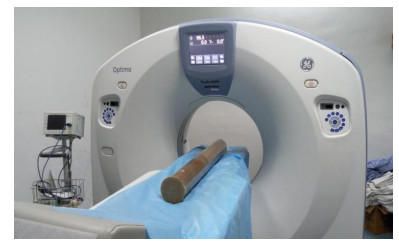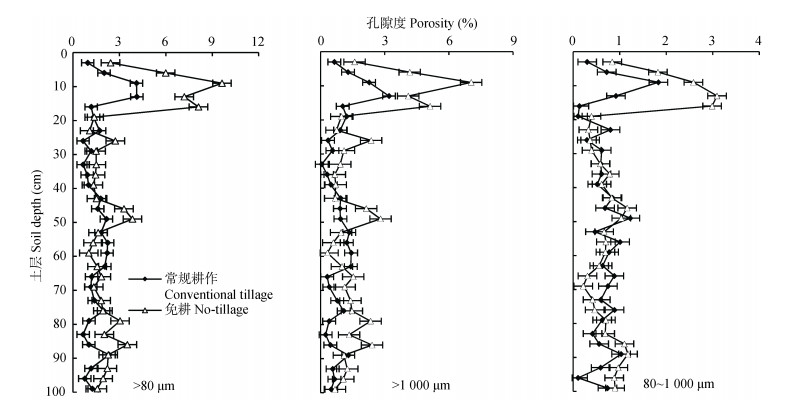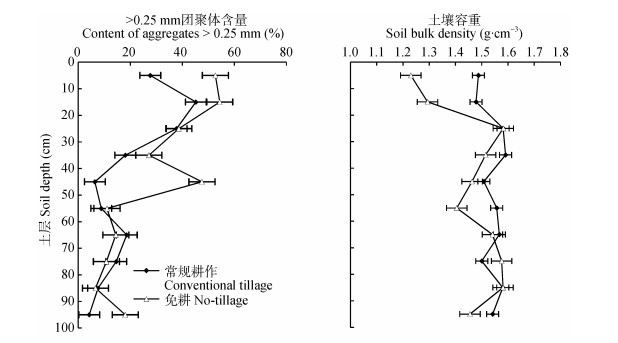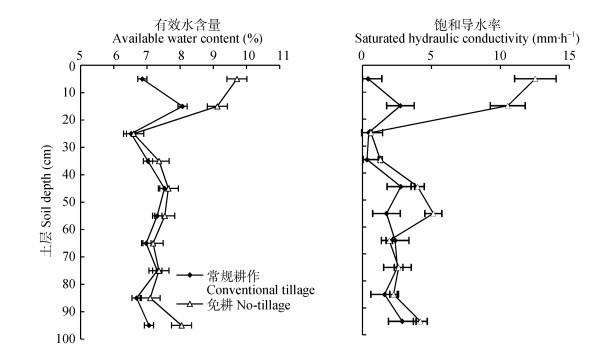2. 农业部作物高效用水原阳科学观测站 原阳 453514;
3. 郑州市金水区总医院 郑州 450001
2. Yuanyang Experimental Station of Crop Water Use, Ministry of Agriculture, Yuanyang 453514, China;
3. Jinshui District General Hospital, Zhengzhou 450001, China
土壤孔隙是土壤结构的重要组成部分, 土壤孔隙的研究能够真实地反映土壤结构状况。自Petrovic等[1]首次将CT技术用来研究土体密度和土壤水分含量以来, 应用CT技术进行土壤结构及孔隙特征方面的研究成为热点。与常规土壤物理分析方法相比, CT扫描方法具有对土体非破坏性分析、分析精度较高(mm至µm尺度)[2]等优点。Anderson等[3]应用CT技术对土壤孔隙进行研究和评价。Peyton等[4]、Zeng等[5]和Perret等[6]利用CT扫描测量了土壤的大孔隙直径和孔隙度。相关研究[7-8]表明, 利用CT扫描图像处理技术可以研究土壤孔隙的分布、土壤密度空间分布及大小、土壤孔隙度、孔隙表面分形维数、土壤含水量空间分布和非饱和导水率等土壤性质。同时, CT扫描技术可准确揭示大孔隙(直径 > 1 mm)的数目、大小和位置[7], 且由常规方法计算出的总孔隙度与CT法得出的结果较为一致[9]。近年来, 人们利用CT扫描法对含有各种大孔隙的原状土柱或填充土柱进行了研究[10-13], 从微观上获得了土壤孔隙的分布特征。
免耕可改善土壤结构[14-15], 降低坡耕旱地水土流失, 增强土壤微生物活性, 降低作物干旱胁迫的伤害[16]。同时, 可提高土壤肥力[17]和土壤孔隙度, 降低土壤容重, 促进作物生长[18]。与传统翻耕技术相比, 免耕下土壤的紧实度、孔隙度和通气状况等发生了根本性的变化[19-20], 免耕减小了耕层土壤总孔隙度和通气孔隙度[21-22]。但Kay[23]指出由传统耕作改为免耕后, 100~500 μm的大孔隙增加, 30~100 μm的中大孔隙减少, > 500 μm的孔隙会随着免耕时间的增加而增加。王殿武等[24]研究发现, 免耕土壤 < 5 μm的小孔隙明显增加, > 50 μm的大、中孔隙明显减少。陈学文等[25]研究发现, 免耕增大了0~5 cm和20~30 cm土层中 > 100 μm大孔隙数量, 减小了耕层5~20 cm土层中30~100 μm次大孔隙。于同艳等[26]研究表明, 免耕虽不利于水分入渗, 但可有效保持土壤中的水分。杨永辉等[27]研究表明, 连续2年免耕可改善土壤结构, 降低土壤容重, 改善土壤孔隙状况, 有利于土壤入渗能力的提高。可见关于免耕对土壤孔隙分布变化的影响研究结果不尽相同, 这可能与土壤类型和种植作物类型、轮作方式及耕作年限等有关。有关这方面的研究已屡见不鲜, 以往的研究多偏重于免耕与普通耕作轮耕或与深松轮耕[28], 且研究深度为犁底层以上的土壤, 而对于长期一直免耕对土壤剖面物理特征及其作用深度等影响如何目前尚鲜见报道, 且长期免耕对土壤孔隙影响的定量分析及其分布特征以及土壤物理参数的影响研究结果存在一定的争议。因此, 分析长期免耕对土体土壤孔隙、土壤结构作用及水分参数的影响, 对土壤改善措施的进一步实施和阐明其对土壤孔隙及相关物理特性影响的作用机理具有重要的科学意义。
笔者对长期免耕条件下0~100 cm土层的土壤孔隙、土壤结构、土壤水分参数及相互关系进行了研究, 为阐明在小麦、玉米轮作过程中, 长期进行免耕对土壤剖面物理特征的改善及其作用机理提供科学依据。
1 材料与方法 1.1 研究区概况试验设置在河南省禹州试验基地(113°03′~ 113°39′E, 33°59′~34°24′N, 海拔116.1 m)进行, 多年平均降水量674.9 mm, 其中60%以上降雨集中在夏季。土壤类型为褐土, 耕层有机质含量12.3 g∙kg-1、全氮含量0.80 g∙kg-1、水解氮含量47.82 mg∙kg-1、速效磷含量6.66 mg∙kg-1、速效钾含量114.8 mg∙kg-1。土壤缺氮少磷富钾。研究区为小麦(Triticum astivum)-玉米(Zea mays)轮作区。土壤机械组成为:砂粒(2~0.02 mm)占59.1%, 粉粒(0.02~0.002 mm)占22.5%, 黏粒(< 0.002 mm)占18.4%。
1.2 试验设计长期定位试验于2006年10月中旬小麦播种时开始, 耕作措施在每年小麦播种时实施, 玉米均为免耕播种。于2014年10月中旬玉米收获后小麦播种翻耕前, 在长期定位试验中选取常规耕作(小麦播种时进行耕作, 耕作深度15 cm, 玉米为免耕播种)和免耕(小麦、玉米播种时均免耕)两个处理进行研究。小区面积为30 m2。分别从定位试验每个处理的3个重复小区中间位置分层采集0~10 cm、10~20 cm、…、90~100 cm原状土(测定土壤团粒结构)、环刀样(测定有效含水量、土壤容重和饱和导水率), 同时利用原状土柱采集器(原状土柱的容器为内直径为90 mm, 厚度为2 mm, 长度为100 cm的PVC硬质管材, 将有机玻璃管放入采集器中, 用铁锤于采集器上方进行竖直敲击, 待采集器进入土中深度110 cm时, 将采集器拔出, 并从采集器的下方取出采集器内的有机玻璃管), 采集0~100 cm原状土柱(用于CT扫描测定土壤孔隙), 带回室内进行分析。试验小区小麦秸秆均全部粉碎覆盖还田, 玉米秸秆全部清离小区。
1.3 CT扫描测定方法 1.3.1 原状土柱的采集分别在不同长期耕作措施中取3个重复土柱带回实验室, 放置于阴凉处待用。室内准备3根直径分别为1.0 mm、2.0 mm和3.0 mm的钢条, 直立在PVC管中, 并装入与原状土柱容重一致的土壤, 填满后再将钢条拔出, 制作3个已知直径的大孔隙作为对照[13-14]。
1.3.2 CT扫描本试验采用医用CT扫描仪(美国GE64排128层CT)。扫描土柱前, 对医用CT装置扫描参数进行重新设定。扫描峰值电压为120 kV, 电流为110 mA, 扫描时间为1 s, 扫描厚度为1 mm, 土柱扫描从顶端每隔1 mm扫描一个横截面, 每土柱共扫描1 000幅横截面图片, 试验共2个处理, 3次重复, 6个土柱, 共得到6 000幅图像。参数设定后, 将土柱放入CT扫描仪(示意图 1)中的X射线管和探测器之间进行扫描, 获得整个土柱不同土层的扫描图像。由于每个土柱图片量较大, 因此选取土柱25 mm、50 mm、75 mm、125 mm、150 mm、175 mm、…、925 mm、975 mm、975 mm处图片进行分析, 即每个土柱分析30幅图片。

|
图 1 CT扫描土壤示意图 Figure 1 Scheme of CT scanning soil |
将得到的土柱横截面CT光盘上的图片保存到计算机中, 得到JPG格式的灰度图像。对CT图像进行图像分析, 图像处理分析采用ImageJ 1.44版本软件[29]。选取分析图像的尺寸为60 mm×60 mm, 面积为3 600 mm2。先将所得CT图像转换为8位图像, 然后进行图像分割。根据已知大孔隙设定阈值, 选取分割阈值为108, 图像分割后, 得到黑白二值图像, 白色部分为基质, 黑色部分为土壤孔隙。分析获得孔隙特征参数包括孔隙的数目、面积、周长、成圆率。
本研究中所能辨别的最小当量孔径为80 μm。通常认为 > 1 000 μm孔隙为大孔隙[30], 因此, 本试验孔隙结果分为当量直径 > 1 000 μm孔隙和当量直径80~1 000 μm孔隙两类。CT测定的总孔隙数(> 80 μm)为 > 1 000 μm孔隙数和80~1 000 μm孔隙数之和。CT测定的 > 1 000 μm孔隙度或80~1 000 μm孔隙度为 > 1 000 μm孔隙或80~1 000 μm孔隙的面积占图像面积的百分数, 总孔隙度(> 80 μm)为 > 1 000 μm孔隙度与80~1 000 μm孔隙度之和。孔隙的成圆率采用如下公式计算得到:
| $ C=4\text{ }\!\!\pi\!\!\text{ }A/{{L}^{2}} $ | (1) |
式中: C为成圆率, 其值介于1和0之间; A为孔隙面积, mm2; L为孔隙周长, mm。
1.4 田间持水量、土壤容重和水稳性团聚含量测定有效含水量和土壤容重采用环刀法[31], 饱和导水率采用恒定水头法[32], 水稳性团聚含量测定采用湿筛法[33]。
1.5 数据统计方法各处理的各指标值均为3次重复的算术平均值。分析所得的数据应用统计学及相关的数理统计软件(SPSS)进行处理。
2 结果与分析 2.1 不同耕作措施对土壤孔隙特征的影响不同措施不同土层的平均孔隙数目、孔隙度及孔隙成圆率如图 2。从图中可知, 免耕处理 > 1 000 μm孔隙数及80~1 000 μm孔隙数均显著高于常规耕作处理, 分别较常规耕作处理提高55.3%和58.2%。免耕在提高了土体孔隙数目的同时, 其土壤孔隙度也显著提高97.4%和39.4%。说明免耕有利于改善土体孔隙状况, 促进孔隙数目与孔隙度的提高。

|
图 2 不同耕作措施对0~100 cm土体 > 1 000 μm和80~1 000 μm孔隙数目、孔隙度及孔隙成圆率的影响 Figure 2 Number, porosity and circularity of > 1 000 μm and 80-1 000 μm pores under different tillage treatments in 0-100 cm soil layer 不同小写字母表示不同耕作措施间差异显著。 Different lowercase letters show significant differences between two tillage treatments. |
孔隙成圆率可表征孔隙的形态特征, 其值越大, 则孔隙越接近于圆形, 说明其孔隙越规则。从图 2可知, 80~1 000 μm孔隙成圆率较大, > 1 000 μm孔隙成圆率较小。说明孔隙越小, 其孔隙越接近于圆形。与常规耕作相比, 免耕处理的孔隙成圆率显著提高。
综上, 进行免耕有利于改善土壤的孔隙状况及其孔隙形态, 从而有利于土壤水分的供应与储存。
2.2 不同耕作措施对0~100 cm土柱不同当量直径土壤孔隙数目的影响由图 3可知, 随着土层深度的增加, 不同类型土壤孔隙数目均表现为先增加再降低, 而30 cm后趋于稳定的趋势。说明不同耕作措施对土壤孔隙的改善主要集中在30 cm以上土层, 但对下层土壤的也有一定的作用。在0~25 cm土层, 免耕处理 > 80 μm的孔隙数目明显高于常规耕作处理。在25~65 cm土层, 免耕处理与常规耕作处理 > 80 μm的孔隙数目差异不显著, 而其在65~75 cm土层低于常规耕作处理。在85~100 cm土层, 免耕处理 > 80 μm的孔隙数目明显高于常规耕作处理。对于大孔隙(> 1 000 μm)数目而言, 在0~10 cm、15~45 cm、50~55 cm和80~100 cm, 免耕处理均高于常规耕作处理, 特别是在0~45 cm土层效果更为显著。对80~1 000 μm土壤孔隙数目而言, 免耕处理在0~25 cm和85~100 cm土层明显高于常规耕作处理。在45~55 cm土层, 免耕处理80~1 000 μm土壤孔隙数目较常规耕作处理高, 但差异不显著。而在其他土层免耕处理80~1 000 μm土壤孔隙数目较少。

|
图 3 不同耕作措施下不同土层 > 80 μm、> 1 000 mm和80~1 000 μm孔隙的数目 Figure 3 Numbers of > 80 μm, > 1 000 μm and 80-1 000 μm pores under different tillage treatments in different soil layers |
综上, 长期免耕更利于改善0~20 cm土层的孔隙状况, 且对20 cm以下土层也产生一定影响。而对于85~100 cm而言, 虽然免耕处理的不同当量直径孔隙度均高于常规耕作, 这可能是土壤本身的分异特征所致, 需要进一步研究。
2.3 不同耕作措施对0~100 cm土柱不同当量直径土壤孔隙度的影响0~100 cm土层不同大小土壤孔隙度如图 4。随土层的加深, 土壤 > 80 μm孔隙度表现为先增加后降低进而趋于稳定的趋势。10~20 cm土层的土壤 > 80 μm孔隙度较其他土层最高。在0~100 cm土层中, 除55~65 cm土层外, 常规耕作处理 > 0.08 mm孔隙度均较低。在0~20 cm、25~40 cm、45~50 cm和75~100 cm土层, 免耕处理 > 80 μm孔隙度均高于常规耕作处理。大孔隙(> 1 000 μm)的孔隙度随土层的加深表现为先增加再降低的趋势。不同处理在20 cm土层以下土层孔隙度均低于3%。在0~20 cm土层, 免耕处理土壤 > 1 000 μm孔隙度明显高于常规耕作处理。在25~40 cm、45~50 cm及65~100 cm土层, 均以免耕处理土壤 > 1 000 μm孔隙度较常规耕作处理高, 但两处理间的差异显著性不同。对于更小级别的孔隙而言, 土壤80~1 000 μm孔隙度随土层的加深表现为先增加后降低再增加最后趋于稳定的趋势。在0~20 cm土层, 免耕处理土壤80~1 000 μm孔隙度均高于常规耕作处理, 其他土层二者表现规律不一致。

|
图 4 不同耕作措施不同土层 > 80 μm、> 1 000 mm和80~1 000 μm孔隙的孔隙度 Figure 4 Porosities of > 80 μm, > 1 000 μm and 80-1 000 μm pores under different tillage treatments in different soil layers |
综上, 长期免耕改善了不同土层的土壤孔隙状况, 提高了土壤总孔隙度、大孔隙度和小孔隙度, 有利于作物根系的生长和水分利用, 其主要影响深度在0~50 cm土层, 特别对0~20 cm土层影响更为显著。
2.4 不同耕作措施对0~100 cm土层> 0.25 mm水稳性团聚体含量及土壤容重的影响由图 5可知, 随土层的加深, > 0.25 mm水稳性团聚体含量表现为先增加再降低的趋势。在0~55 cm和90~100 cm土层, > 0.25 mm水稳性团聚体含量表现为:免耕 > 常规耕作。在55~85 cm土层, 常规耕作处理 > 0.25 mm水稳性团聚体含量较免耕处理高。说明长期进行免耕促进了作物根系的生长, 减少了因耕作对土壤结构的破坏, 从而提高了土壤剖面结构的稳定性, 尤其是55 cm以上土层。

|
图 5 不同耕作措施对不同土层土壤 > 0.25 mm团聚体含量及容重的影响 Figure 5 Effects of different tillage treatments on > 0.25 aggregates content and soil bulk density in different soil layers |
土壤容重反映了土壤紧实度、孔隙及结构特征。由图 5可知, 随土层的加深, 土壤容重表现为先增加而后趋于稳定的趋势。而不同土层中以0~20 cm土层的土壤容重明显小于其他土层。在0~20 cm和30~60 cm土层, 常规耕作处理的容重明显高于免耕处理。而在70 cm以下土层二者差异不显著。
综上, 长期免耕更利于改善0~55 cm土层的土壤结构, 提高该土层的土壤结构稳定性, 有利于作物根系的生长。
2.5 不同耕作措施对0~100 cm土层土壤有效水含量及土壤饱和导水率的影响由图 6可知, 常规耕作处理不同土层的有效水含量介于6.0%~8.0%, 在25 cm以下土层, 其有效水含量介于6.5%~7.5%。而免耕处理不同土层的土壤有效水含量变幅较大。免耕处理在0~100 cm土层土壤有效水含量均高于常规耕作处理, 特别在0~20 cm土层效果最显著。

|
图 6 不同耕作措施对不同土层土壤有效水含水量及饱和导水率的影响 Figure 6 Effects of different tillage treatments on available water content and saturated hydraulic conductivity in different soil layers |
不同处理25~35 cm土层的土壤饱和导水率最低。免耕0~20 cm的土壤饱和导水率明显高于常规耕作, 这是由于常规耕作在小麦播种进行耕作时破坏了土壤的团粒结构所致。在25~45 cm土层, 免耕与常规耕作处理之间差异较小。随土层的进一步加深, 二者的差异逐渐加大, 免耕45~55 cm土层的土壤饱和导水率仍高于常规耕作, 这可能是免耕后土壤水分较为充足, 促进了作物根系生长和蚯蚓活动频繁所致。但在65 cm土层以下, 二者的差异逐渐减小。说明经过长期免耕措施后, 由于土壤结构得到了改善, 土壤剖面导水性能提高, 尤其是0~20 cm以上土层效果更为显著。
2.6 不同土壤物理特征相关性分析对土壤孔隙特征参数及 > 0.25 mm水稳性团聚体含量等进行相关性分析得出(表 1): > 0.25 mm水稳性团聚体含量、饱和导水率及有效水含量与不同孔径的孔隙度(数目)均呈极显著(P < 0.01)正相关, 而土壤容重与不同孔径的孔隙度(数目)均呈极显著(P < 0.01)负相关。说明不同土壤物理特性之间存在极好的相关性, 可选取其中1个指标来表征其他指标。
| 表1 土壤孔隙特征与土壤团聚体含量及容重和含水量间的相关性 Table 1 Correlation between soil pore characters and soil aggregates content, bulk density and water content |
长期进行不同耕作会对耕层乃至深层土壤产生深远影响, 主要表现为土体团粒结构、土壤孔隙及土壤水分参数等的变化。土壤孔隙结构及在土体的分布影响水分在土体中的迁移, 与土壤表面径流及渗透性之间具有密切关系[34], 对土壤肥力也有多方面的影响[35]。土壤孔隙的数目、大小、形状、方向及空间分布等, 决定着土壤中水分的流量、流速、流态及持水性能[36]。大孔隙既利于水分的渗透, 又是土壤空气与大气交换的直接通道, 中等孔隙适合根的生长, 小孔隙有保持和运行土壤水分和养分的功能。
免耕能够改善土壤结构和土壤孔隙, 增加土壤水分入渗[37], 提高土壤持水性能, 防治土壤质量退化[38]。陈学文等[25]研究认为, 免耕使得土壤自然沉实, 土壤容重增大, 孔隙度降低。而杨永辉等[27]应用CT扫描法研究发现, 免耕可有效提高表层土壤的孔隙度, 这可能与免耕年限有关。Asare等[39]应用CT扫描技术研究发现大孔隙度随着深度增加有明显减少的趋势, 并认为大孔隙的形成机理与地上残留物、植物根系类型及土壤动物等因素有关。甘磊等[40]研究发现, 在0~30 cm土层中, 随土层的加深, 免耕的孔隙数目有增加的趋势。本研究发现, 随土层的加深, 孔隙数目及孔隙度呈现先增加(0~20 cm)再降低而后趋于稳定的趋势。通过长期免耕不仅提高了表层土壤的总孔隙数(> 80 μm)、大孔隙数(> 1 000 μm)及80~1 000 μm孔隙数, 且不同类型的孔隙度也相应增加。与常规耕作相比, 免耕更利于提高0~25 cm土层80~1 000 μm和 > 80 μm孔隙数目和0~45 cm土层 > 1 000 μm孔隙数目。同时, 免耕提高了0~20 cm和25~40 cm土层 > 1 000 μm、> 80 μm与0~20 cm土层80~1 000 μm的土壤孔隙度。说明, 耕作对下层土壤的压实作用, 尤其在犁底层附近, 引起土壤容重增加, 孔隙度减少[41], 而免耕处理的土壤结构更稳定, 利于孔隙数目及孔隙度的提高, 这与Kay等[42]的研究结果一致, 而与Carter[43]的研究结果相反。这可能与土壤类型或气候等条件不同有关, 需要进一步深入研究。
长期免耕会对土壤的其他物理特性产生重要影响[44]。田效琴等[45]研究表明, 长期免耕可显著降低0~20 cm土层的容重, 提高水稳性团聚体含量和土壤孔隙度, 而对于20~40 cm土层效果不明显。Hammel[46]和Hatfield等[47]研究表明, 长期免耕导致表层土壤容重增加、耕层变浅、结构变差。而余海英等[48]、Gao等[49]和Huang等[50]均研究表明, 免耕覆盖可降低土壤容重、提高土壤孔隙度、促进土壤水稳性团聚体的形成。而对于更深层次土层, 本研究发现, 长期免耕在改善了土体土壤孔隙状况的同时, 提高了0~55 cm土层 > 0.25 mm水稳性团聚体含量、0~60 cm土层的土壤饱和导水率、0~25 cm土层的有效水含量, 降低了0~65 cm土层的土壤容重, 从而改善了剖面土壤物理环境, 有利于作物的生长, 其作用深度在0~55 cm土层。但也有研究[51-52]表明, 长期免耕导致土壤紧实, 容重增加。这可能与土壤质地有关。如, 刘威等[53]研究不同质地土壤时发现, 免耕增加了壤土的土壤容重, 降低了其土壤孔隙度, 而提高了粉质壤土的孔隙度, 降低了土壤容重。说明免耕对不同质地土壤的作用效果存在一定的差异, 需要进一步研究。
综上, 通过CT扫描测得的土壤孔隙参数与常规方法测定的土壤物理参数之间存在极好的相关性, 可从微观土壤孔隙特征来表征宏观的土壤物理性质。在褐土旱作区进行长期免耕, 有利于改善土体土壤结构和土壤孔隙状况, 提高土壤的渗透能力及土壤水分的有效性, 促进作物的生长。其对不同土壤物理参数的作用深度存在一定的差异, 其综合作用深度在55 cm以上土层, 而继续进行免耕的结果如何, 还有待下一步研究。
| [1] | PETROVIC A M, SIEBERT J E, RIEKE P E. Soil bulk density analysis in three dimensions by computed tomographic scanning[J]. Soil Science Society of America Journal, 1982, 46(3): 445–450. DOI:10.2136/sssaj1982.03615995004600030001x |
| [2] | GANTZER C J, ANDERSON S H. Computed tomographic measurement of macroporosity in chisel-disk and no-tillage seedbeds[J]. Soil and Tillage Research, 2002, 64(1/2): 101–111. |
| [3] | ANDERSON S H, PEYTON R L, GANTZER C J. Evaluation of constructed and natural soil macropores using X-ray computed tomography[J]. Geoderma, 1990, 46(1/3): 13–29. |
| [4] | PEYTON R L, GANTZER C J, ANDERSON S H, et al. Fractal dimension to describe soil macropore structure using X ray computed tomography[J]. Water Resources Research, 1994, 30(3): 691–700. DOI:10.1029/93WR02343 |
| [5] | ZENG Y, PAYTON R L, GANTZER C J, et al. Fractal dimension and lacunarity of bulk density determined with X-ray computed tomography[J]. Soil Science Society of America Journal, 1996, 60(6): 1718–1724. DOI:10.2136/sssaj1996.03615995006000060016x |
| [6] | PERRET J, PRASHER S O, KANTZAS A, et al. Preferential solute flow in intact soil columns measured by SPECT scanning[J]. Soil Science Society of America Journal, 2000, 64(2): 469–477. DOI:10.2136/sssaj2000.642469x |
| [7] | WAMER G S, NIEBER J L, MOORE I D, et al. Characterizing macropores in soil by computed tomography[J]. Soil Science Society of America Journal, 1989, 53(3): 653–660. DOI:10.2136/sssaj1989.03615995005300030001x |
| [8] | PEYTON R L, HAEFFNER B A, ANDERSON S H, et al. Applying X-ray CT to measure macropore diameters in undisturbed soil cores[J]. Geoderma, 1992, 53(3/4): 329–340. |
| [9] | PHOGAT V K, AYLMORE L A G. Evaluation of soil structure by using computer-assisted tomography[J]. Australian Journal of Soil Research, 1989, 27(2): 313–323. DOI:10.1071/SR9890313 |
| [10] |
赵世伟, 赵勇钢, 吴金水. 黄土高原植被演替下土壤孔隙的定量分析[J]. 中国科学:地球科学, 2010, 40(2): 223–231.
ZHAO S W, ZHAO Y G, WU J S. Quantitative analysis of soil pores under natural vegetation successions on the Loess Plateau[J]. Science China Earth Science, 2010, 40(2): 223–231. |
| [11] |
吴华山, 陈效民, 陈粲. 利用CT扫描技术对太湖地区主要水稻土中大孔隙的研究[J]. 水土保持学报, 2007, 21(2): 175–178.
WU H S, CHEN X M, CHEN C. Study on macropore in main paddy soils in Tai-Lake Region with CT[J]. Journal of Soil and Water Conservation, 2007, 21(2): 175–178. |
| [12] |
冯杰, 郝振纯. CT扫描确定土壤大孔隙分布[J]. 水科学进展, 2002, 13(5): 611–617.
FENG J, HAO Z C. Distribution of soil macropores characterized by CT[J]. Advances in Water Science, 2002, 13(5): 611–617. |
| [13] |
杨永辉, 武继承, 韩庆元, 等. 保水剂对土壤孔隙影响的定量分析[J]. 中国水土保持科学, 2011, 9(6): 88–93.
YANG Y H, WU J C, HAN Q Y, et al. Quantitative analysis of the effect of water-retaining agent on soil pores[J]. Science of Soil and Water Conservation, 2011, 9(6): 88–93. |
| [14] | MARTÍNEZ E, FUENTES J P, SILVA P, et al. Soil physical properties and wheat root growth as affected by no-tillage and conventional tillage systems in a Mediterranean environment of Chile[J]. Soil and Tillage Research, 2008, 99(2): 232–244. DOI:10.1016/j.still.2008.02.001 |
| [15] |
雷金银, 吴发启, 王健, 等. 保护性耕作对土壤物理特性及玉米产量的影响[J]. 农业工程学报, 2008, 24(10): 40–45.
LEI J Y, WU F Q, WANG J, et al. Effects of conservation tillage on soil physical properties and corn yield[J]. Transactions of the CSAE, 2008, 24(10): 40–45. DOI:10.3321/j.issn:1002-6819.2008.10.009 |
| [16] |
周静, 张仁陟. 不同耕作措施下春小麦应对干旱胁迫的生理响应[J]. 干旱区研究, 2010, 27(1): 39–43.
ZHOU J, ZHANG R Z. Physiological response of spring wheat to drought stress under different cultivation measures[J]. Arid Zone Research, 2010, 27(1): 39–43. |
| [17] |
康红, 朱保安, 洪利辉, 等. 免耕覆盖对旱地土壤肥力和小麦产量的影响[J]. 陕西农业科学, 2001, 46(9): 1–3.
KANG H, ZHU B A, HONG L H, et al. Effects of zero-tillage and mulching on the soil fertility and wheat yield in the arid land[J]. Shaanxi Journal of Agricultural Sciences, 2001, 46(9): 1–3. |
| [18] | ACHARYA C L, SHARMA P D. Tillage and mulch effects on soil physical environment, root growth, nutrient uptake and yield of maize and wheat on an alfisol in north-west India[J]. Soil and Tillage Research, 1994, 32(4): 291–302. DOI:10.1016/0167-1987(94)00425-E |
| [19] | IMHOFF S, GHIBERTO P J, GRIONI A, et al. Porosity characterization of Argiudolls under different management systems in the Argentine Flat Pampa[J]. Geoderma, 2010, 158(3/4): 268–274. |
| [20] | EDWARDS W M, SHIPITALO M J, TRAINA S J, et al. Role of Lumbricus terrestris (L.) burrows on quality of infiltrating water[J]. Soil Biology and Biochemistry, 1992, 24(12): 1555–1561. DOI:10.1016/0038-0717(92)90150-V |
| [21] | KUSHWAHA C P, TRIPATHI S K, SINGH K P. Soil organic matter and water-stable aggregates under different tillage and residue conditions in a tropical dryland agroecosystem[J]. Applied Soil Ecology, 2001, 16(3): 229–241. DOI:10.1016/S0929-1393(00)00121-9 |
| [22] | DA VEIGA M, HORN R, REINERT D J, et al. Soil compressibility and penetrability of an Oxisol from southern Brazil, as affected by long-term tillage systems[J]. Soil and Tillage Research, 2007, 92(1/2): 104–113. |
| [23] | KAY B D. Rates of change of soil structure under different cropping systems[M]//STEWART B A. Advances in Soil Science 12. New York: Springer, 1990: 1-52 |
| [24] |
王殿武, 褚达华. 少、免耕对旱地土壤物理性质的影响[J]. 河北农业大学学报, 1992, 15(2): 28–33.
WANG D W, CHU D H. Effect of zero tillage and minimum tillage on physical properties of soil in dryland[J]. Journal of Hebei Agricultural University, 1992, 15(2): 28–33. |
| [25] |
陈学文, 张晓平, 梁爱珍, 等. 耕作方式对黑土耕层孔隙分布和水分特征的影响[J]. 干旱区资源与环境, 2012, 26(6): 114–120.
CHEN X W, ZHANG X P, LIANG A Z, et al. Tillage effects on soil pore size distribution and soil moisture in Northeast China[J]. Journal of Arid Land Resources and Environment, 2012, 26(6): 114–120. |
| [26] |
于同艳, 张兴义. 耕作措施对黑土农田耕层水分的影响[J]. 西南大学学报:自然科学版, 2007, 29(3): 121–124.
YU T Y, ZHANG X Y. Effects of different soil tillage systems on soil water in the black farmland[J]. Journal of Southwest University:Natural Science Edition, 2007, 29(3): 121–124. |
| [27] |
杨永辉, 武继承, 毛永萍, 等. 利用计算机断层扫描技术研究土壤改良措施下土壤孔隙[J]. 农业工程学报, 2013, 29(23): 99–108.
YANG Y H, WU J C, MAO Y P, et al. Using computed tomography scanning to study soil pores under different soil structure improvement measures[J]. Transactions of the CSAE, 2013, 29(23): 99–108. DOI:10.3969/j.issn.1002-6819.2013.23.014 |
| [28] |
王玉玲, 李军, 柏炜霞. 轮耕体系对黄土台塬麦玉轮作土壤生产性能的影响[J]. 农业工程学报, 2015, 31(1): 107–116.
WANG Y L, LI J, BAI W X. Effects of rotational tillage systems on soil production performance in wheat-maize rotation field in Loess Platform region of China[J]. Transactions of the CSAE, 2015, 31(1): 107–116. |
| [29] | ABRAMOFF M D, MAGELHÃES P J, RAM S J. Image processing with imageJ[J]. Biophotonics International, 2004, 11(7): 36–42. |
| [30] | WARNER G S, NIEBER J L, MOORE I D, et al. Characterizing macropores in soil by computed tomography[J]. Soil Science Society of America Journal, 1989, 53(3): 653–660. DOI:10.2136/sssaj1989.03615995005300030001x |
| [31] |
中国科学院南京土壤研究所. 土壤理化分析[M]. 上海: 上海科学技术文献出版社, 1995.
Institute of Soil Science, Chinese Academy of Sciences. Soil Agricultural Chemistry Analysis[M]. Shanghai: Shanghai Science and Technology Literature Press, 1995. |
| [32] |
欧少亭. 林业管理常用标准及政策法规汇编——森林土壤渗透性测定[M]. 长春: 吉林电子出版社, 2002.
OU S T. Compilation of Commonly Used Standards, Policies and Regulations for Forestry Management:Determination of Forest Soil Permeability[M]. Changchun: Jilin Electronic Publishing House, 2002. |
| [33] |
中国科学院南京土壤研究所土壤物理研究室. 土壤物理性质测定法[M]. 北京: 科学出版社, 1978.
Institute of Soil Science, Chinese Academy of Sciences. Determination Methods for Soil Physical Properties[M]. Beijing: Science Press, 1978. |
| [34] | POESEN J, INGELMO-SANCHEZ F. Runoff and sediment yield from topsoils with different porosity as affected by rock fragment cover and position[J]. CATENA, 1992, 19(5): 451–474. DOI:10.1016/0341-8162(92)90044-C |
| [35] |
杜建涛, 何文清, NANGIA V, 等. 北方旱区保护性耕作对农田土壤水分的影响[J]. 农业工程学报, 2008, 24(11): 25–29.
DU J T, HE W Q, NANGIA V, et al. Effects of conservation tillage on soil water content in northern arid regions of China[J]. Transactions of the CSAE, 2008, 24(11): 25–29. DOI:10.3321/j.issn:1002-6819.2008.11.005 |
| [36] |
陈浩, 李洪文, 高焕文, 等. 多年固定道保护性耕作对土壤结构的影响[J]. 农业工程学报, 2008, 24(11): 122–125.
CHEN H, LI H W, GAO H W, et al. Effect of long-term controlled traffic conservation tillage on soil structure[J]. Transactions of the CSAE, 2008, 24(11): 122–125. DOI:10.3321/j.issn:1002-6819.2008.11.023 |
| [37] |
杨永辉, 武继承, 张洁梅, 等. 耕作方式对土壤水分入渗、有机碳含量及土壤结构的影响[J]. 中国生态农业学报, 2017, 25(2): 258–266.
YANG Y H, WU J C, ZHANG J M, et al. Effect of tillage method on soil water infiltration, organic carbon content and structure[J]. Chinese Journal of Eco-Agriculture, 2017, 25(2): 258–266. |
| [38] |
陈源泉, 隋鹏, 高旺盛, 等. 中国主要农业区保护性耕作模式技术特征量化分析[J]. 农业工程学报, 2012, 28(18): 1–7.
CHEN Y Q, SUI P, GAO W S, et al. Quantitative analysis on technological characteristics of different conservation tillage patterns in major agricultural regions of China[J]. Transactions of the CASE, 2012, 28(18): 1–7. DOI:10.3969/j.issn.1002-6819.2012.18.001 |
| [39] | ASARE S N, RUDRA R P, DICKINSON W T, et al. SW-soil and water:Soil macroporosity distribution and trends in a no-till plot using a volume computer tomography scanner[J]. Journal of Agricultural Engineering Research, 2001, 78(4): 437–447. DOI:10.1006/jaer.2000.0659 |
| [40] |
甘磊, 张静举, 黄太庆, 等. 基于CT技术的甘蔗地不同耕作措施下土壤孔隙结构研究[J]. 西南农业学报, 2017, 30(8): 1843–1848.
GAN L, ZHANG J J, HUANG T Q, et al. Pore structure in sugarcane soil under different tillage managements based on CT scanning[J]. Southwest China Journal of Agricultural Sciences, 2017, 30(8): 1843–1848. |
| [41] | GAN L, PENG X, PETH S, et al. Effects of grazing intensity on soil thermal properties and heat flux under Leymus chinensis and Stipa grandis vegetation in Inner Mongolia, China[J]. Soil and Tillage Research, 2012, 118: 147–158. DOI:10.1016/j.still.2011.11.005 |
| [42] | KAY B D, VANDENBYGAART A J. Conservation tillage and depth stratification of porosity and soil organic matter[J]. Soil and Tillage Research, 2002, 66(2): 107–118. DOI:10.1016/S0167-1987(02)00019-3 |
| [43] | CARTER M R. Characterizing the soil physical condition in reduced tillage systems for winter wheat on a fine sandy loam using small cores[J]. Canadian Journal of Soil Science, 1992, 72(4): 395–402. DOI:10.4141/cjss92-033 |
| [44] |
许淑青. 不同农作方式对耕层土壤理化性质的影响[D]. 兰州: 甘肃农业大学, 2008: 22-24
XU S Q. Effects of the different agricultural tillage methods on soil physical and chemical properties in tilth soil[D]. Lanzhou: Gansu Agricultural University, 2008: 22-24 http://cdmd.cnki.com.cn/Article/CDMD-10733-2009029187.htm |
| [45] |
田效琴, 田佳乔, 李卓, 等. 保护性耕作下西南黄壤坡地的土壤结构效应[J]. 中国农学通报, 2017, 33(14): 62–68.
TIAN X Q, TIAN J Q, LI Z, et al. Soil structure effect of conservation tillage in yellow soil slope cropland in southwest China[J]. Chinese Agricultural Science Bulletin, 2017, 33(14): 62–68. |
| [46] | HAMMEL J E. Long-term tillage and crop rotation effects on bulk density and soil impedance in northern Idaho[J]. Soil Science Society of America Journal, 1989, 53(5): 1515–1519. DOI:10.2136/sssaj1989.03615995005300050036x |
| [47] | HATFIELD J L, SAUER T J, PRUEGER J H. Managing soils to achieve greater water use efficiency[J]. Agronomy Journal, 2001, 93(2): 271–280. DOI:10.2134/agronj2001.932271x |
| [48] |
余海英, 彭文英, 马秀, 等. 免耕对北方旱作玉米土壤水分及物理性质的影响[J]. 应用生态学报, 2011, 22(1): 99–104.
YU H Y, PENG W Y, MA X, et al. Effects of no-tillage on soil water content and physical properties of spring corn fields in semiarid region of northern China[J]. Chinese Journal of Applied Ecology, 2011, 22(1): 99–104. |
| [49] | GAO M, LUO Y J, WANG Z F, et al. Effect of tillage system on distribution of aggregates and organic carbon in a hydragric anthrosol[J]. Pedosphere, 2008, 18(5): 574–581. DOI:10.1016/S1002-0160(08)60051-X |
| [50] | HUANG S, SUN Y N, RUI W Y, et al. Long-term effect of no-tillage on soil organic carbon fractions in a continuous maize cropping system of northeast China[J]. Pedosphere, 2010, 20(3): 285–292. DOI:10.1016/S1002-0160(10)60016-1 |
| [51] | BLANCO-CANQUI H, LAL R. Soil structure and organic carbon relationships following 10 years of wheat straw management in no-till[J]. Soil and Tillage Research, 2007, 95(1/2): 240–254. |
| [52] | HE J, LI H W, WANG X Y, et al. The adoption of annual subsoiling as conservation tillage in dryland maize and wheat cultivation in northern China[J]. Soil and Tillage Research, 2007, 94(2): 493–502. DOI:10.1016/j.still.2006.10.005 |
| [53] |
刘威, 黄丽, 鲁剑巍, 等. 两种保护性耕作对土壤养分、结构和产量的影响[J]. 土壤通报, 2015, 46(2): 420–427.
LIU W, HUANG L, LU J W, et al. Effects of conservation tillages on soil nutrients, structure and crop yield[J]. Chinese Journal of Soil Science, 2015, 46(2): 420–427. |
 2018, Vol. 26
2018, Vol. 26



